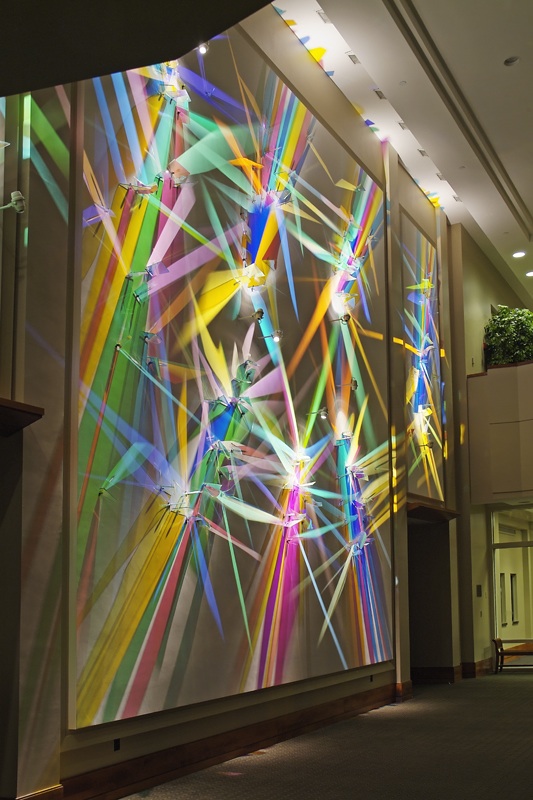|
Lightpainting
Lightpainting is an art form developed by artist Stephen Knapp and introduced in 2002. Lightpainting uses white light projected in space through specially coated glass that breaks the light into bands of color, producing optically complex virtual 3D images that sit at the intersection of painting and sculpture. Lightpaintings can take the form of moveable wall-mounted panels but the most spectacular effects are achieved in large-scale architectural installations. Layers of metallic coating are applied to glass pieces to refract and reflect colors, which becomes the palette to be used as pure chroma or mixed into a wide spectrum of colors. Glass is cut into various sizes and shapes that determine planes of color and other elements that can be used much as in traditional painting or sculpture. Lightpainting (one word) is not to be confused with light painting Light painting, painting with light, light drawing, or light art performance photography are terms that describe phot ... [...More Info...] [...Related Items...] OR: [Wikipedia] [Google] [Baidu] |
Stephen Knapp
Stephen Knapp (October 15, 1947November 24, 2017) was an American artist best known for his use of the medium of lightpainting. A native of Worcester, Massachusetts, he gained an international reputation for large-scale works of art held in museums, public, corporate, and private collections, which are executed in media as diverse as light, kiln-formed glass, metal, stone, mosaic, and ceramic. Knapp wrote and lectured on architectural art glass, the collaborative process, and the integration of art and architecture. His work has appeared in many publications including ''Art and Antiques, Architectural Record, ARTnews, Ceramics Monthly, The Chicago Sun Times, Honoho Geijutsu, Identity, Interior Design, Interiors, The New York Times, Nikkei Architecture, Progressive Architecture, Sculpture (magazine),'' and ''90+10.'' Life and work Stephen Knapp graduated from Worcester Academy in 1965 and received his B.A. from Hamilton College in 1969. For nearly a decade after graduating from col ... [...More Info...] [...Related Items...] OR: [Wikipedia] [Google] [Baidu] |
Light Painting
Light painting, painting with light, light drawing, or light art performance photography are terms that describe photographic techniques of moving a light source while taking a long-exposure photograph, either to illuminate a subject or space, or to shine light at the camera to 'draw', or by moving the camera itself during exposure of light sources. Practiced since the 1880s, the technique is used for both scientific and artistic purposes, as well as in commercial photography. Light painting also refers to a technique of image creation using light directly, such as with LEDs on a projective surface using the approach that a painter approaches a canvas. History Light painting dates back to 1889 when Étienne-Jules Marey and Georges Demeny traced human motion in the first known light painting ''Pathological Walk From in Front''. The technique was used in Frank Gilbreth's work with his wife Lillian Moller Gilbreth in 1914 when the pair used small lights and the open shutter of ... [...More Info...] [...Related Items...] OR: [Wikipedia] [Google] [Baidu] |
Colorfulness
Colorfulness, chroma and saturation are attributes of perceived color relating to chromatic intensity. As defined formally by the International Commission on Illumination (CIE) they respectively describe three different aspects of chromatic intensity, but the terms are often used loosely and interchangeably in contexts where these aspects are not clearly distinguished. The precise meanings of the terms vary by what other functions they are dependent on. * Colorfulness is the "attribute of a visual perception according to which the perceived color of an area appears to be more or less chromatic"., page 87. The colorfulness evoked by an object depends not only on its spectral reflectance but also on the strength of the illumination, and increases with the latter unless the brightness is very high ( Hunt effect). * Chroma is the "colorfulness of an area judged as a proportion of the brightness of a similarly illuminated area that appears white or highly transmitting". As a resu ... [...More Info...] [...Related Items...] OR: [Wikipedia] [Google] [Baidu] |


